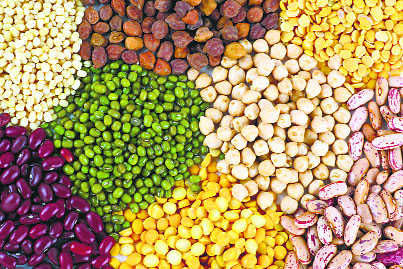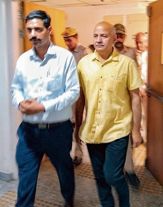
Pulse production needs long-term planning.
Yoginder K. Alagh
As the Indian economy grows at a rate of 7 per cent plus, assuming low growth as an aberration, the food basket will diversify. Within grains, the movement will be to pulses as shown by the expert group on pulse production. The yield and production of pulses has remained low. According to a report of the Ministry of Agriculture, the number of districts with yields more than 0.8 or 1 tonne per hectare yield of kharif pulses is small (Andhra Pradesh one, Bihar four, Gujarat five, Karnataka seven, Rajasthan seven and Uttar Pradesh five). There is some improvement since 2011. The expert group discussed the strategies for pulse production and the Ministry of Agriculture gave them operational focus.
The gap between demand and supply has been widening and has necessitated the import of pulses of around 3 million tonne. The Indian Institute of Pulses Research (IIPR) estimates 25.39 million tonne of demand by 2024-25. By using nutrition norms and per capita “need,” econometric estimates of the demand elasticity of pulses ranges from 1.5 to 2.0. This would mean that with an increase of around 6.5 per cent annual in per capita income, the demand for pulses would increase around 10 per cent annually.
The main reason for stagnation in the area under pulses has been the differential impact of technology and relative profitability, thereby leading to shifting of the area under pulses to more remunerative crops. Expansion of irrigation was another factor. Uncontrolled water flow (flooding), common in canal systems, is incompatible with large-scale area under pulses, which needs protective irrigation. Pulses continue to be grown under unirrigated rain-fed conditions, in marginal lands. Thus, the yield suffered due to instability.
India did not figure in major technological breakthroughs in the world, with countries like Canada and others achieving averages of around two tonne per hectare in pulses productivity. Technology breakthroughs in the difficult regions and adverse farming conditions (rainfed regions, the ghats and hill regions) was just not there on a large scale. The possibilities for increasing the area under pulses existed in the agro-economic domain.
The utilisation of potential area of rice fallow lands of 3 to 4 million hectares is there in specified districts, largely in Eastern India. Again, in some areas there was relative advantage. About 5 lakh ha area of upland rice, 4.5 lakh ha area of millets and 3 lakh ha area under barley, mutsard and wheat, currently giving low yields. Summer mung bean as a filler crop is possible in North-west India, as also in Gujarat and West Bengal. Districts where watershed development has succeeded in recent years gives scope for pushing pulses development. Pigeon pea on rice bunds and intercropping in specific agro-climatic regimes is possible.
There is pressure in Delhi for free trade in pulses. Contrarily, we believe that there is an urgent need to blend domestic price policy with tariff policy so that domestic price of pulses stabilise. Import duties on pulses need to be calibrated in response to the demand-and-supply situation. The minimum support price with subsidies and without tariffs, subsidises farmers in countries exporting to India and not its own farmers. It is like a policy of pouring water in a leaking bucket. Procurement centres with adequate storage facilities need to be established at the district and block level in major pulse-growing zones. The negative economics of stocking limit orders, trading movement controls, licensing requirements and other controls has to be faced. Public-private partnerships (PPP) are now possible since the private sector has entered this area in an innovative manner, with storages also acting as market and financial support mechanisms for farmers. With the available technologies given policy support, pulse productivity can rise by around a quarter. If a long-term plan is absent, there can be no question of achieving pulse demands towards the end of the decade. If plans are not set in place now the desired outcomes will not be achieved. To develop the next-generation germ plasm, we need at least five to seven years. That is why long-term planning and action is needed. Expert groups have noted that a detailed plan for achieving experimental yields of two-and-a-half tonne per hectare, as in some countries like Canada, are not available in India.
Both for resources and management of details, a PPP mode will be needed. The public sector ICAR system will need to take the strategic initiatives. India is too big for the world to feed its growth. We can only use trade to adjust at the margin. The programmes of development outlined above will raise yield by about 12 to 15 quintals per hectare. If we get on the drawingboard now, it would take four to five years. We need such strategies for many pulse crops. For this, both money and mobilisation of scarce technical talent are required. We also need great management and organisational abilities to cover the last mile in a long-haul problem.
The Director General, International Crops Research Institute for the Semi-Arid Tropics (ICRISAT), has endorsed the need to plan for yields of above two tonnes per hectare in different agro-climatic regimes. The plan will cost hundreds of crores, if the experience of hybrid paddy is any indication. For example, a highly productive seed chipper machine of Monsanto costs a billion dollars. Apart from organisation, economic strategies for rewarding technology are needed. The national regulator suggested in legislation should be designed and implemented by law. We are going through an extremely destructive regulation of states like Andhra Pradesh, Gujarat and Maharashtra, through state price control acts. By cutting down normal profits after research and development, this will discourage investment in the sector. In April 2011, the Gujarat High Court struck down the right of the state government to regulate seed prices.
The writer, Chancellor of the Central University of Gujarat, is a former Chairman of the Expert Group on Pulses.



























